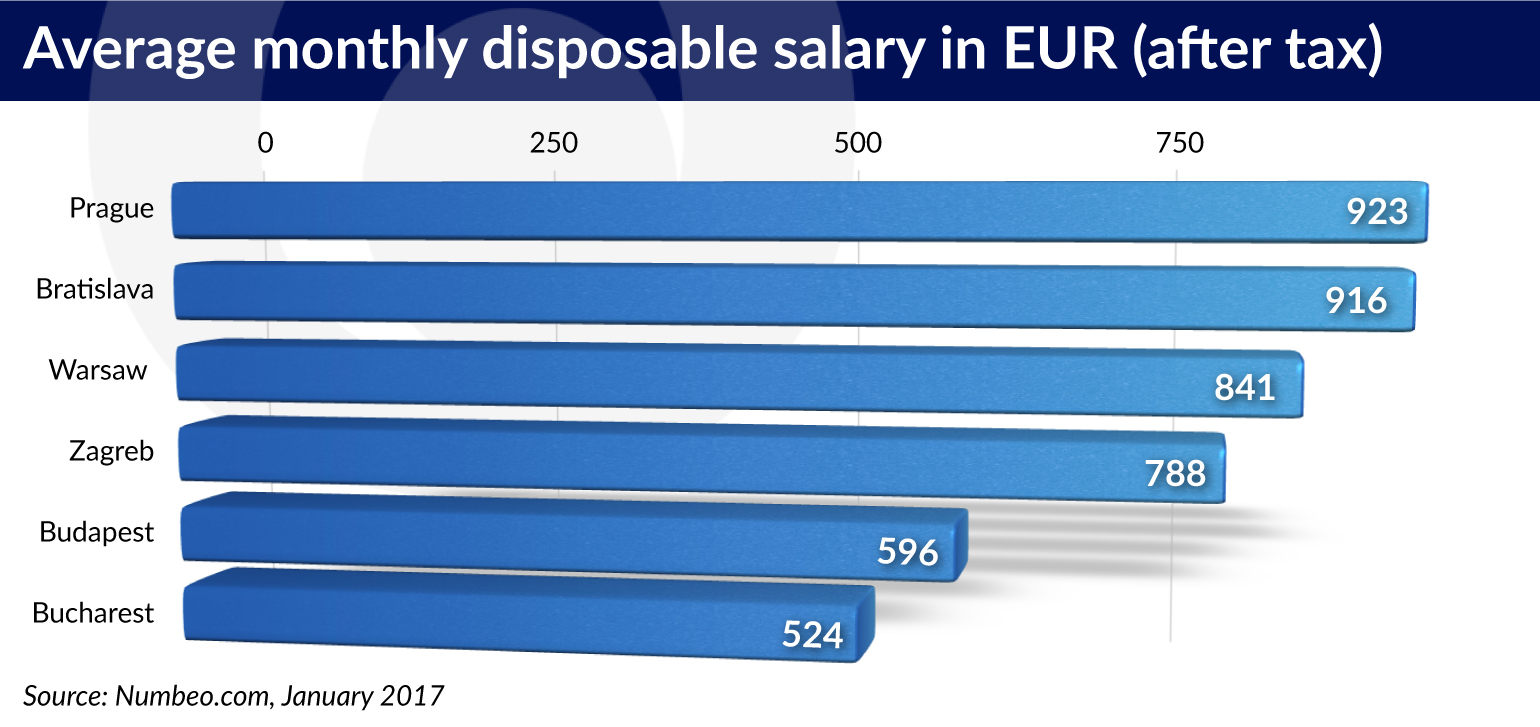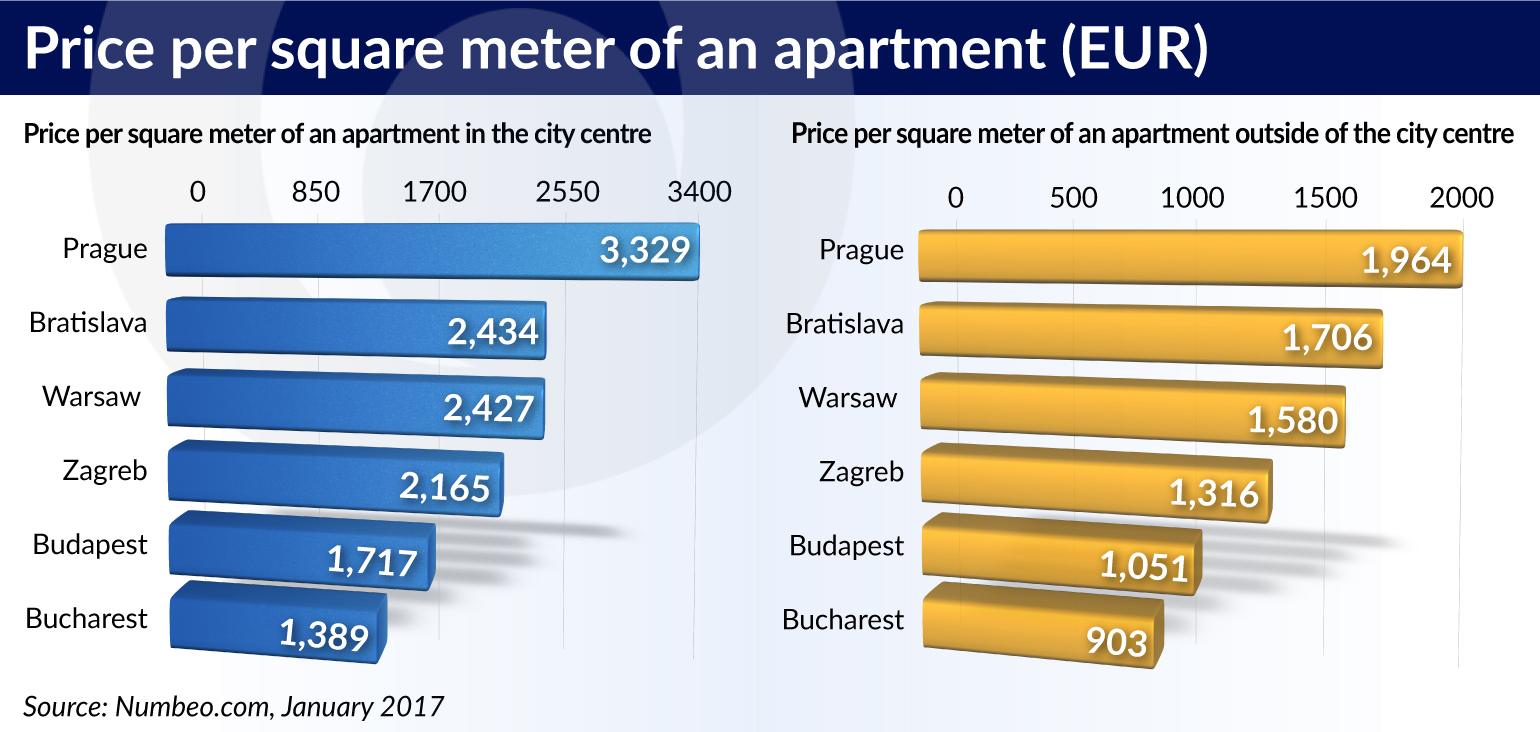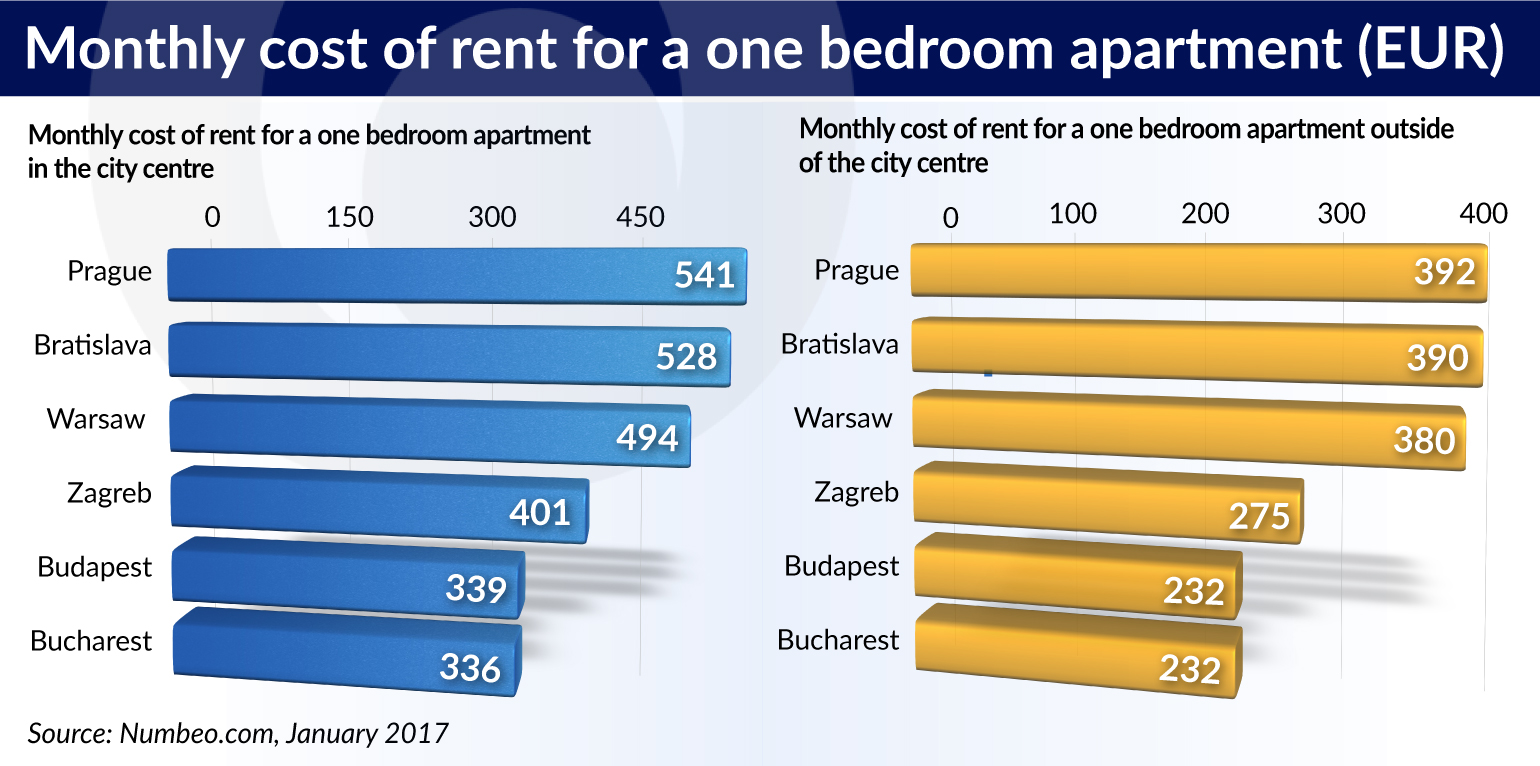Tydzień w gospodarce
Category: Trendy gospodarcze
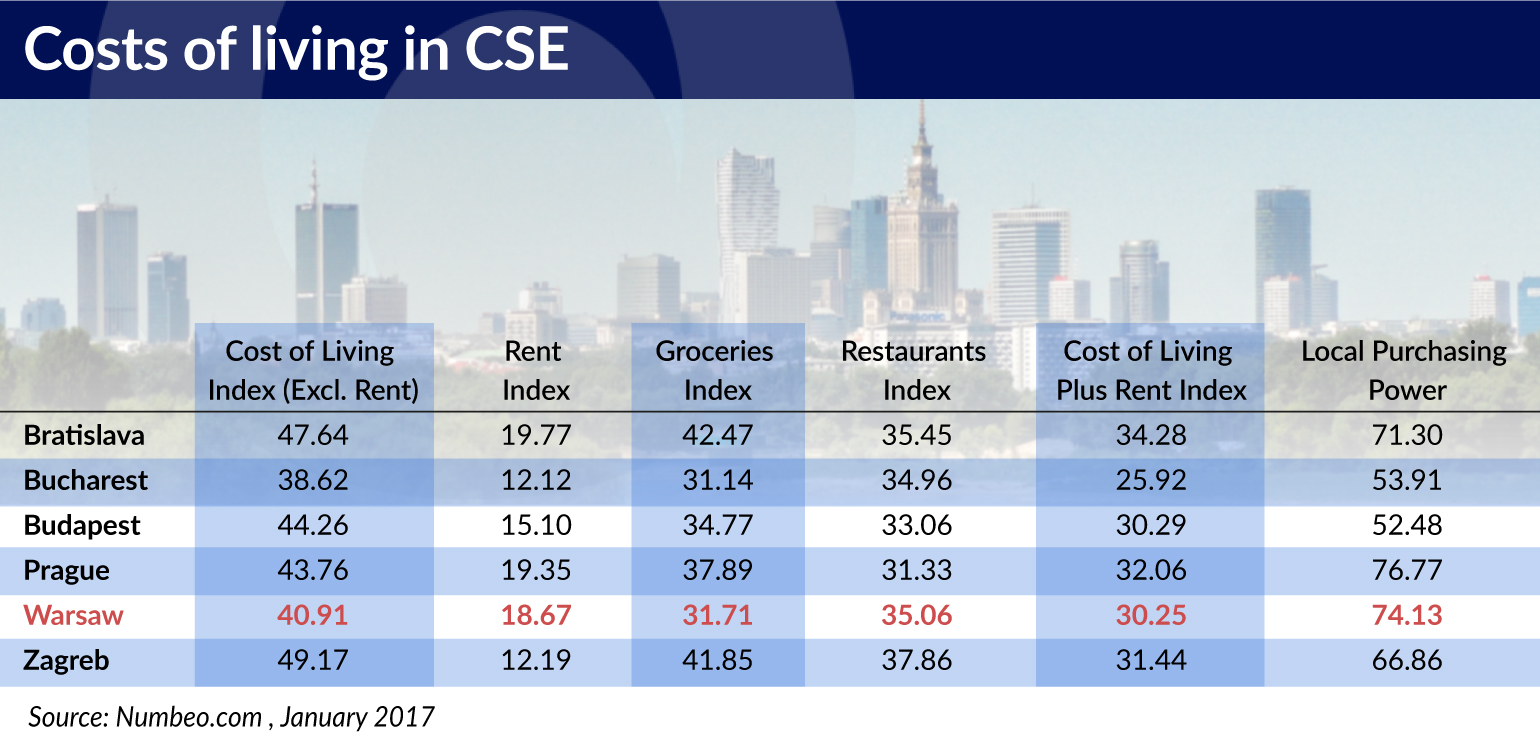
Their scores in the Human Development Index indicate that these are highly developed countries, despite the fact that average salaries seem to be low by Western European standards.
Poland, Hungary, and Czech Republic may appear quite attractive to citizens of Western countries. First of all, they offer relatively low costs of living, including prices of houses and flats. Secondly, low terror threat makes CSE safer than the Western Europe. According to the Global Terrorism Index Report 2016-2017, Poland is the 147th country in terms of terrorism threat, Romania is the 149th, Slovakia is the 152nd, Hungary the 98th, and Czech Republic is the 67th. Meanwhile, the United Kingdom is the 27th, France the 35th and Germany the 52nd. Therefore, more and more Westerners are interested in Central and Southeast Europe.
The cost of living and average salaries in the CSE do not differ extremely from those in other countries, although in some areas they may be considered significant. So we have decided to analyze the costs of living, local purchasing power, and average monthly disposable salaries in the capital cities of Poland (Warsaw), the Czech Republic (Prague), Slovakia (Bratislava), Hungary (Budapest), Romania (Bucharest), and Croatia (Zagreb). Those countries appears to be the most important new members of the EU, admitted in or after 2004.
First, it is noteworthy to have a closer look at the Cost of Living Index (Excluding Rent) according to the “Numbeo” website. The most expensive cities are Zagreb (49.17 points) and Bratislava (47.64). These results may be considered surprising at the first glance. Budapest got 44.26 points, whereas Prague 43.76 and Warsaw 40.91 point. The cheapest city is Bucharest with 38.62 points. The lowest Rent Index is in the Romanian capital (only 12.12 points), then in Zagreb (12.19) and in Budapest (15.10). Warsaw got 18.67 points, whereas Prague got 19.35 but the highest Rent Index is in Bratislava (19.77). However, if we consider costs of living and the Rent Index combined, it turns out that the most expensive city remains the capital of Slovakia (34.28), followed by Prague (32.06) and Zagreb (31.44). Budapest got slightly more points (30.29) than Warsaw (30.25). The cheapest city turned out to be Bucharest with 25.92 points.
Basic groceries are the cheapest for inhabitants of Bucharest (31.14 points) and Warsaw (31.71), more expensive in Budapest (34.77) and Prague (38.89). The most expensive are in Bratislava (42.47) and Zagreb (41.85). This may explain why the Croatian capital have such a relatively high costs of living. Zagreb has also the most expensive restaurants (37.86 in the Restaurant Index), whereas the cheapest ones are definitely in Prague (31.33). It may come as a surprise, considering that Prague is one of the most popular tourists destinations in Europe. The highest local purchasing power is in Prague (76.77 points), and then in Warsaw (74.13) and Bratislava (71.30). Zagreb got 66.86 points, and the residents of Bucharest (53.91) and of Budapest (52.48) have the lowest local purchasing power.
Secondly, we should analyze average salaries in those capital cities. The highest average salaries are paid in Prague. According to the “Numbeo”, an average monthly, disposable salary (after taxation) in the capital city of the Czech Republic amounts to about EUR923. A little bit less is paid to employees in Bratislava: EUR916 per month. In Warsaw, the average monthly disposable salary is EUR841, and significantly lower is Budapest, where it is about EUR596. But still higher than in Bucharest, where it amounts to about EUR524 and less than in Zagreb. In the Croatian capital the average monthly disposable salary amounts to about EUR788.
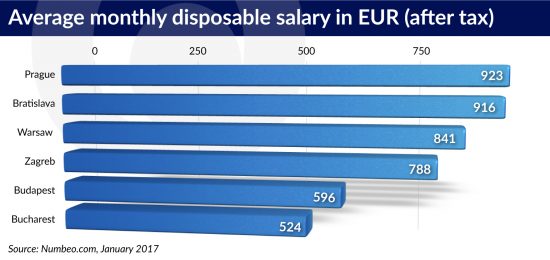
Thirdly, one of the most important issues is the cost of purchasing a flat. The price of one square meter is definitely the highest in Prague. In the city center it’s EUR3,329. If anyone wants to live in the city center of Bratislava or Warsaw, the average price for a square meter are similar (EUR2,434 and EUR2,427 respectively). In Zagreb it’s EUR2,165, whereas it only costs EUR1,717 in the beautiful city center of Budapest. The cheapest city is Bucharest, where the price is only EUR1,389 per square meter.
Prague also has the most expensive properties outside of the city center. Average price per square meter in the Czech capital city amounts to EUR1,964, while it is EUR1,706 in Bratislava and EUR1,580 in Warsaw. In Zagreb the average price of a square meter outside of the city center amounts to EUR1,316, whereas it is EUR1,051 in Budapest and only EUR903 in Bucharest.
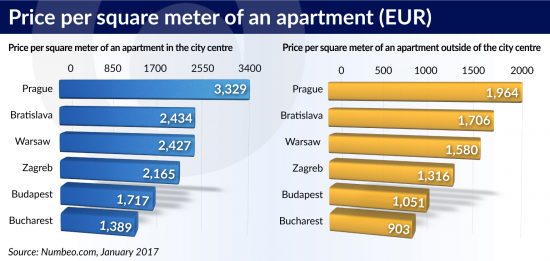
It is noteworthy to emphasize that the differences are smaller if we analyze the average monthly rent for a one bedroom apartment. In Prague it is EUR541 in the city center and EUR392 outside of the center. In Bratislava the average rent is EUR528 for an apartment in the city center and EUR390 outside of the city center. In Warsaw it is EUR494 and EUR380 respectively, whereas in Budapest EUR401 and EUR275. The cheapest apartments can be rented in Bucharest (EUR336 in the city center and EUR232 outside of the city center). Zagreb is only a little bit more expensive: the average monthly rent per month for a one-bedroom apartment in the city center is EUR339 and EUR 232 outside of the city center.
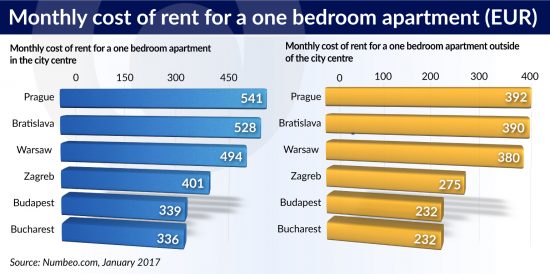
So, where to live in CSE?
Among the capital cities of CSE the highest local purchasing power is in Prague. In spite of the fact, that the average price for apartments (including rent) seems relatively high in comparison to other capital cities in the region, residents of Prague receive the highest average monthly disposable salary, the costs of living are lower than in Bratislava and, rent prices excluded, lower than in Budapest and Zagreb. Prices of groceries are not the highest either, as the inhabitants of the Czech capital city have to pay less than people living in Budapest or Zagreb. Dining out in Prague is the cheapest, even cheaper than in Bucharest. The local purchasing power in Prague is 8.54 per cent lower than in London, 9.51 per cent lower than in Madrid, and only 5.44 per cent higher than in Rome.
Warsaw also places itself in a good position comparing with the rest of the cities. The Polish capital offers low costs of living; only Bucharest has lower ones. At the same time, the average salary in Warsaw amounts to EUR841, more than in Zagreb, Budapest, or Bucharest. Warsaw takes the high place as far as the local purchasing power is concerned. Relatively cheap groceries are important, and their prices are over 25 per cent lower than in Bratislava and only 1.84 per cent higher than in Bucharest. Warsaw’s local purchasing power is 3.44 per cent lower than in Prague, 11.69 per cent lower than in London, 1.81 per cent higher than in Rome, and 44.82 per cent higher than in Athens.
The lowest local purchasing power is in Budapest and Bucharest. However, rent prices are relatively attractive, which may be a very important factor for foreigners.
Michał Kowalczyk is a PhD student at the History and Social Science Department of the Cardinal Stefan Wyszyński University in Warsaw. He specializes in Hungarian and Central European politics.
